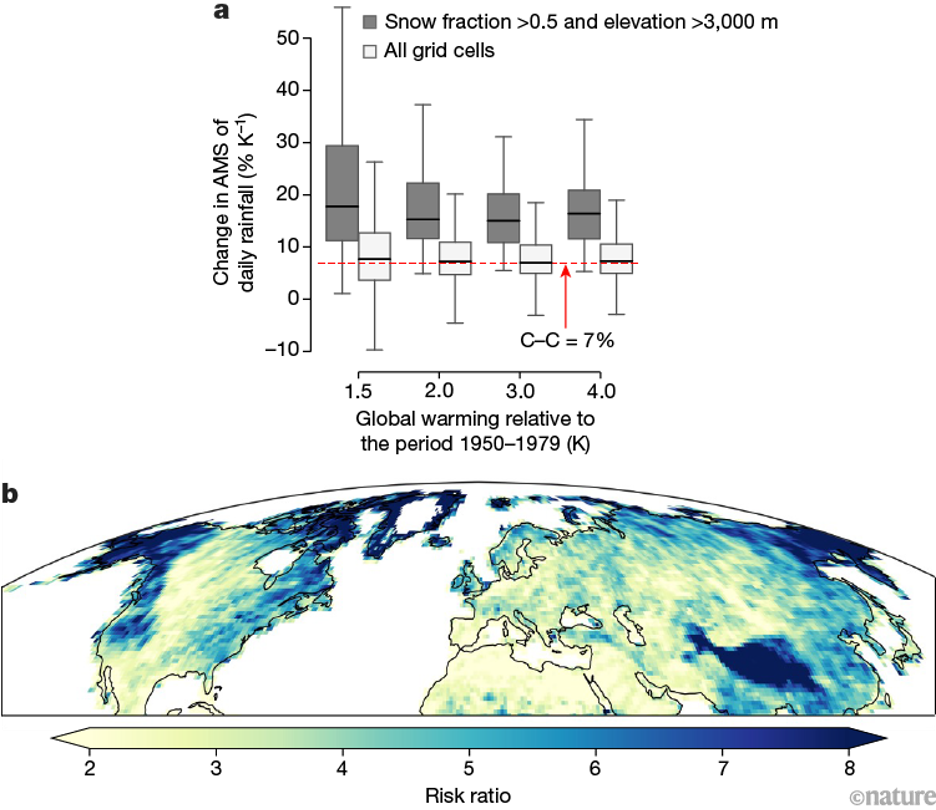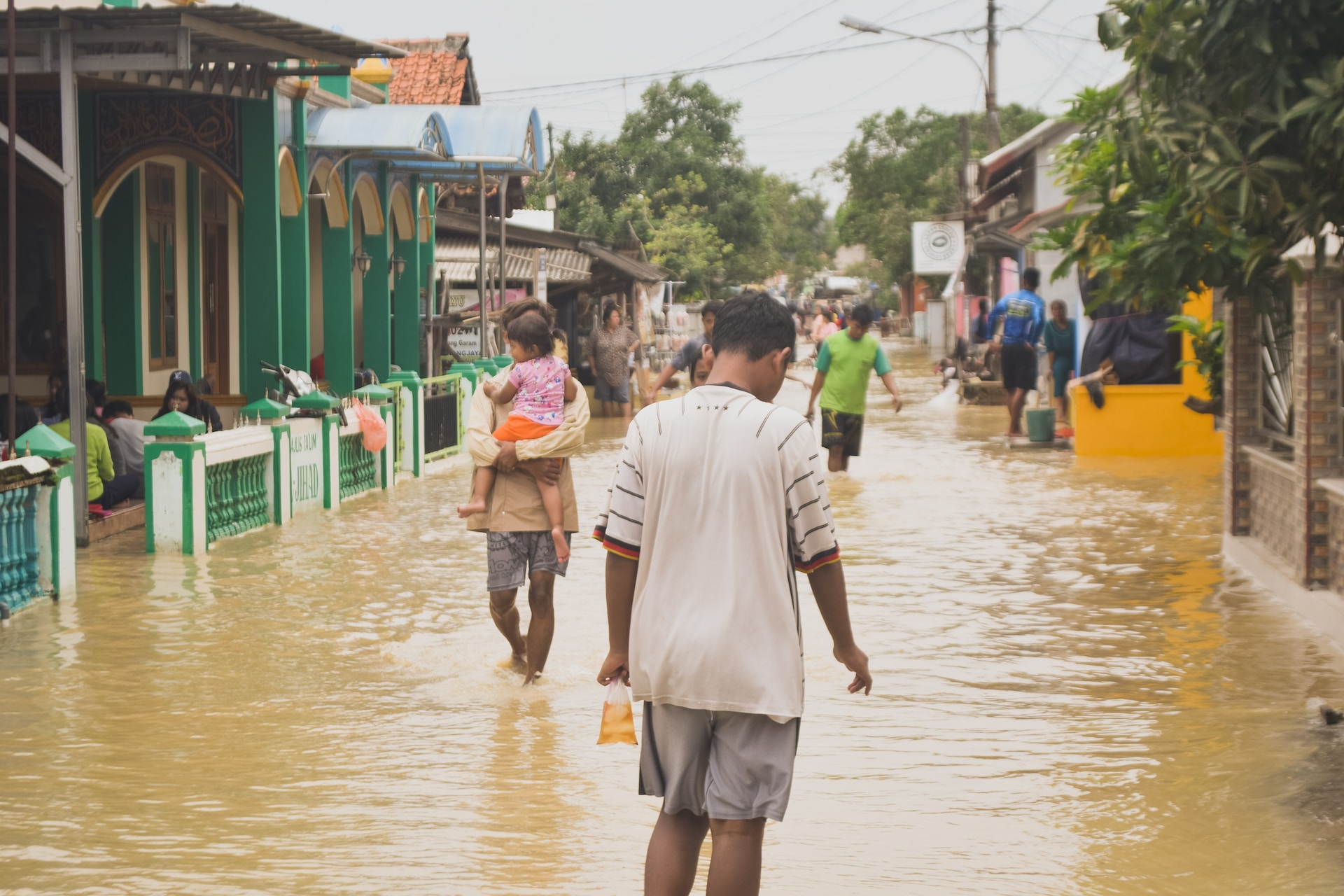In a new study citing the latest work published by the MRI Elevation Dependent Climate Change Working Group (Pepin et al., 2022), researchers reveal that as the climate warms, the intensification of rainfall extremes in high-elevation regions is amplified by approximately 15% per degree Celsius of warming, twice the previously reported rate, due to increased atmospheric water vapor and a shift towards more rain and less snow.
The Question
Global warming has been reported to increase the intensity of precipitation extremes at an approximate rate of 7% per degree Celsius of warming1,2 by increasing the amount of water vapour in the atmosphere. In addition, warming is expected to lead to a shift from solid-phase precipitation (snow) to liquid-phase precipitation (rain) in high-elevation regions3. These two findings together raise the question of whether — and if so, to what extent — high-elevation regions are at increased risk of rainfall extremes owing to a synergy of both mechanisms. Moreover, it is not clear whether increases in rainfall extremes that are projected to occur by the end of this century are similar to those estimated from the historical record, or how future warming expected by 2100 might affect increases in rainfall extremes. These questions are important because of the damage caused by rainfall-related hazards, such as floods, landslides and soil erosion.
The Discovery
We investigated the questions above using data from several sources. For historical context, we used a climate reanalysis data set developed by combining model simulations and observations. Future changes in rainfall were simulated using several global climate models. We used more than 40 simulation data sets corresponding to different models, warming levels and time periods. All these data sets provide estimates of precipitation phase, enabling analysis of rainfall extremes. More specifically, we used a statistical analysis based on extreme-value theory to explore changes in intensity and risk of extreme rainfall in the Northern Hemisphere between 20° N and 90° N.
We found that the rate of increase in the intensity (magnitude) of rainfall extremes in high-elevation regions due to global warming is approximately 15% per degree Celsius of warming (Fig. 1a). This rate is evident in both the historical data record (1950–2019) and modelled future projections (2024–2100). In mountainous regions it is approximately double that in low-elevation regions between 20° N and 90° N (Fig. 1a), indicating that high-elevation regions are particularly vulnerable to future risk of rainfall extremes. Notably, the rate of increase in rainfall extremes is linearly related to warming level. Our findings also reveal that climate models differ in their estimates of the increase in rainfall extremes, mainly because of differences in how they simulate snow fraction (the proportion of precipitation that falls as snow) and the way in which it changes with warming.

Figure 1 | Global warming is predicted to intensify rainfall in high-elevation regions. a, Percentage change in the intensity of extreme daily rainfall (annual maximum series, AMS) in the Northern Hemisphere predicted with different amounts of global warming. Box plots depict increases across grid cells with the median, 25th and 75th percentiles; whiskers show the maximum and minimum values after removing outliers. Light-grey boxes show results from the entire analysed region (20° N–90° N). Dark-grey boxes show results for grid cells more than 3,000 metres above sea level and with a snow fraction (the proportion of precipitation that falls as snow) greater than 0.5. The red dashed line indicates the increase in atmospheric water vapour resulting from warming (the Clausius–Clapeyron relationship1, C–C). b, Map of the Northern Hemisphere showing the projected increase in extreme daily rainfall by 2100 relative to 1950–1979 (the risk ratio). Darker areas are predicted to be more prone to increased rainfall extremes with global warming.
The Implications
Estimates of extreme rainfall are often considered when designing infrastructure. Our findings, therefore, call for updates to infrastructure design codes in high-elevation regions to account for the increased risk of rainfall extremes in a future climate. Estimates of extreme rainfall are also often used to model the risk of landslides. More intense rainfall brings a greater risk of landslides in high-elevation regions, necessitating the development of specific mitigation and adaptation plans. Our results could also reduce uncertainty in model projections of rainfall extremes by identifying snow fraction as a key component of rainfall models.
Our analysis was limited to the Northern Hemisphere from 20° N to 90° N (Fig. 1b). We excluded the Southern Hemisphere owing to well-documented issues regarding the quality and availability of observations. We also excluded the tropics (20° S–20° N) from our analyses because of uncertainties in model simulations of precipitation. Our study covers most of the global inhabited land area, including several mountainous regions (Fig. 1b), but extending the analysis to the Southern Hemisphere will be valuable for exploring extreme-rainfall patterns in regions such as the Andes.
For this study, we mainly used simulation data sets of climate models and reanalysis data sets. Future work should explore the amplification of rainfall extremes as more data sets become available from both in situ and remotely sensed observations. Such an analysis might either corroborate our findings or highlight local anomalies.
Citation
Ombadi, M., Risser, M.D., Rhoades, A.M. et al. A warming-induced reduction in snow fraction amplifies rainfall extremes. Nature (2023). https://doi.org/10.1038/s41586-023-06092-7
This research briefing was written by Mohammed Ombadi at the Lawrence Berkeley National Laboratory, Berkeley, California, USA and first published by Nature. Read the original briefing here.
Cover Image by: Misbahul Aulia







